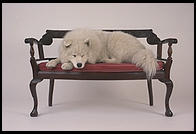
Studio Photography
by Philip Greenspun; revised February 2010
Site Home : Photography : Studio Photography

by Philip Greenspun; revised February 2010
Site Home : Photography : Studio Photography
Studio photography is easy because you can get exactly what you want. Studio photography is hard because you can get exactly what you want.
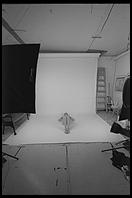
Soft light, hard light, hair light, background. Everything is under your control. If you are a tremendously creative person who knows how to use studio equipment, you'll get wonderful results. If you are uncreative, you'll have very flat and boring results. If anything is wrong with the lighting balance or exposure, you'll have nobody to blame but yourself.
Most big cities have good rental studios that come complete with lights, backgrounds, and often assistants. This is the way to go if you have a big budget and know exactly when you want to shoot. Having your own studio, especially at home, is great for spontaneous work and also because you can take some of your equipment on location.
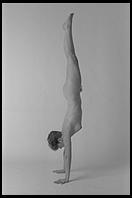
Decide whether you want your studio to be floor-based or ceiling-based. A floor-based studio means that you have lightstands for the lights and background supports for the background. All of these supports are very lightweight because they are designed to be portable. You'll be treading very carefully and/or you'll be knocking things over.
In a ceiling-based studio, you mount background rollers on the ceiling and a rail system that allow flexible positioning of lights anywhere within a rectangular area. A ceiling-based studio costs about $1000 more than a floor-based one, but is a much nicer place to work since you don't have to worry about knocking lights over.
The coolest part of any rail system is the pantograph light support. These pull down from the ceiling and are cleverly counterbalanced so that they just stay wherever you leave them. You just grab a light and move it up or down an inch and it stays there. Pure mechanical design magic. As far as I know, the Manfrotto Skytrack system (my personal choice; explained at www.manfrotto.com), a FOBA system (imported by SinarBron), and the Calumet system (www.calumetphoto.com) are the only rail systems available in the US.
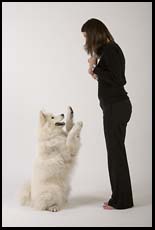
Decide what format camera you'll be using. Bigger cameras require smaller apertures to get adequate depth of field and hence more light. Decide how big your subjects are going to be. Head-and-shoulders portraits require much less light than automobiles.
To learn about hot lights, read one of the many good books written for cinematographers on the subject. With flashes, 500 watt-seconds is sufficient for digital or 35mm photography of people at full-length. The smaller strobe systems also work for 4x5 view camera photography of tabletop subjects. Most serious studio photographers start with about 2000 watts-seconds, which is adequate for 4x5 photography of large subjects, and will rent another pack if they have to light something huge.
If you have any windows in your studio, you might be able to use the sunlight coming in. The color temperature of sunlight varies from about 2000K at sunrise to 4300K in the early morning to 5800K at high noon in midsummer. [Note: the sun streaming into a window is different from what you get if you take your subject out into the open. "Daylight" is a combination of sunlight (around 5500K) and skylight (approx 9500K), averaging to around 6500K in the summer. Clouds or shade push the color temperature much bluer, up towards 9000K, though an overall overcast is usually 6000K.]
Once you know how much light you need, decide whether to go hot, warm, or cold. "Hot lights" are traditional tungsten or Metal Halide Iodide (HMI) lights that burn continuously. The big advantages of hot lights are
Not too many still photographers use hot lights, though, because they have the following disadvantages:
HMI lights are mercury medium-arc iodide lights that burn at a color temperature of between 5600K and 6000K. They produce about 4X the light of a tungsten bulb with the same wattage because less energy is wasted as heat. Also, you don't have to waste energy and light filtering to daylight color balance. That said, if you get yourself a 36,000 watt Ultra Dino, you won't exactly be shivering in the studio. The smallest HMI lights seem to be about 200 watts.
[Hot light anecdote: In 2009, I hired a summer intern, who had finished three years studying film and video production at Emerson College, to work with me on a series of videos for people learning to fly helicopters. He brought his own equipment to the first day of filming, including some "work lights" from Home Depot. To get a clear image of the instrument panel, he positioned these lights directly behind my $3000 Sony high-def camcorder. Within a minute, the camcorder screen melted and the entire machine was nearly hot enough to catch fire. The experience inspired me to write an article on how our university system is affecting economic growth.]
Suppose that a clever person invented a light bulb that was just as bright as an incandescent ("tungsten") bulb, but used much less electricity and therefore ran much cooler? Fortunately for photographers, this invention exists. It is called the fluorescent light bulb. For most of the 20th Century, fluorescent lights had a spectrum that was too peaky to give natural-looking color with film cameras. In the 21st Century, however, there are all kinds of fluorescent bulbs available, including very bright compact fluorescent bulbs with a reasonably high color rendering index (CRI) and daylight color temperature. If you put five 100W equivalent CFL bulbs together, you get the light output of a 500W "hot light" without much more heat than the modeling light of a cold strobe (see below). It is possible to use "warm lights" with soft boxes and other light control attachments that are designed for strobes.
The most popular warm light is the Westcott Spiderlite TD5/TD3 series. I've used these with good results for both still photos and video. Breaking down these lights for travel and setting them back up is more time-consuming than with either hot or cold lights. The CFL bulbs are too fragile to remain in the fixture and have to be taken out and put into cardboard boxes (where they may break anyway).
With some warm lights there is a potential for uneven illumination when using faster shutter speeds, e.g., 1/500th of a second. Fluorescent lights have a certain amount of flicker that human eyes average out, but the camera shutter could catch the bulbs as they in a dim part of the cycle. Consequently, warm lights or strobes will likely be better for fast-moving subjects.
Note: Do not confuse the Spiderlite TD5/TD3 with the original "Spiderlite", which uses a conventional halogen bulb.
My dream warm light does not seem to exist. Let's consider that a very common studio light control technique these days is the softbox (see below), which generates a shadowless diffuse light from a large rectangular surface. Can we think of any shadowless diffuse bulbs? How about conventional fluorescent tubes? Imagine taking eight 36" long bulbs. You would now have a bright diffuse 24x36" rectangular source of light (not very different from a light table). Tubes are a little more rugged than the CFL bulbs, so it should be possible to transport the light box with the tubes installed. As far as I can tell, nobody sells a light like this for mounting on light stands. Perhaps it would be too heavy, in which case we'll have to wait for the next frontier... LED-based warm lights. Lightpanels makes some of these already but the price-performance is not competitive with other technologies as of 2010.
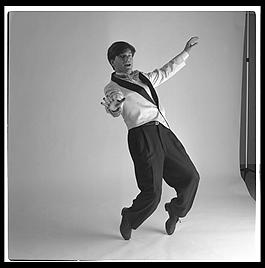
"Cold lights" are electronic flashes, much more powerful than the ones on your camera but basically the same idea. Studio strobes come in two flavors: monolights and powerpack/head systems. The business end of both is the same, a flash tube surrounding an incandescent bulb. The incandescent bulb, usually around 100 watts, is the "modeling light," used by the photographer to judge lighting effects and ratios. These aren't very effective if the ambient light in the studio, e.g., from windows, is high. In the old days, most photographers would burn a few Polaroids to make sure that the lights are properly set. In the digital era, the easiest way to preview is with a digital camera directly connected to a computer, with each new exposure displayed on a big LCD monitor.
A monolight has a wall outlet on one end, a flash tube on the other, and a big block of capacitors in between. These are nice for location work because you don't have have a lot of cables running around. Using several monolights together isn't as much of a problem as you'd think because (1) good monolights have a 4 or 5 f-stop output adjustment control, and (2) most monolights have a built-in slave so that when one fires, they will all fire.
In a powerpack/head system, you have one big heavy capacitor-filled power pack and a bunch of relatively lightweight heads connected by high-voltage cables to the powerpack. You can adjust the lighting power among the heads and also the overall light output. These are the most flexible and most commonly used studio flash systems. Flash power is specified in watt-seconds (joules), somewhat confusingly abbreviated as "w/s".
Choosing a brand of studio strobes is a similar process to choosing an SLR camera system. If you buy the wrong brand, you may have to scrap your entire investment as your ambitions grow. In the world of monolights, Sunpaks are cheap (around $300 each for 500 w/s or in a 1600 w/s kit), have been around for a long time, and allow stepless power adjustment over a 5 f-stop range. Sunpak makes an interesting combination monolight/softbox called a DigitFlash that is probably ideal if you're sure that you never need a hard light. If you feel like spending twice as much money for the same power output, there are monolights from a lot of professional strobe vendors that will possibly accept a wider variety of light-control accessories.
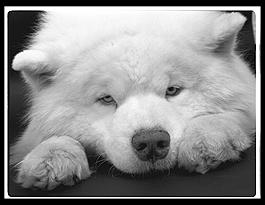
In powerpack/head systems, Novatron should be the cheapest system you consider. Anything cheaper probably won't work in the long run and won't fit any of the standard light control accessories. Novatron sells kits that include cheap umbrellas and light stands in a big plastic case. You can use these to go on location as long as you're not worried about some big-time professional walking by and calling you a girlie-man because you don't have Speedotron. Example kits range from 240 w/s, two heads to 600 w/s, three heads. The main problems with Novatron are that (1) the packs only have adustable power output over a 2 or 3 f-stop range, and (2) the heads won't take more than 500 or 1000 w/s of power.
If spending 2-4X as much money per w/s is acceptable, you will no doubt be very happy with Speedotron Black Line, Norman, Dyna-Lite, Broncolor, or Calumet systems. These allow you to pump 2000 or 3000 w/s into a single head, adjust over a 5 or 6 f-stop range, have more powerful modeling lights, and are presumably more reliable in heavy use. Many of these systems offer interesting zoom heads that allow adustment of the light cone angle.
Warning: there is a brand of mail-order flash called White Lightning (Paul Buff) that is sold as X watt-seconds for N dollars. These supposedly aren't such horrible flashes but the claimed watt-seconds figures are absurd. The true output is something like X/2, which means that their monolights aren't any cheaper than other cheap brands.
Note for high speed photography: Studio flash systems generally take between 1/200th and 1/1500th of a second to dump out their light. This is fast enough to freeze much motion but won't stop a bullet or give you a perfectly sharp splash. Studio strobes were designed for relatively long illumination times because color film suffered some reciprocity failure at the very short exposure times of on-camera flashes that aren't working hard. In other words, Kodak and Fuji did not guarantee that film photographers would got correct color balance at 1/50,000 of a second because the red, green, and blue layers of the film respond differently to being illuminated for so short a time. Options for high-speed photography are (1) use an on-camera flash set for 1/32nd power, or (2) get a studio strobe system specifically designed for stop-motion capability, e.g., Profoto (and add a trigger system from Kapture Group).
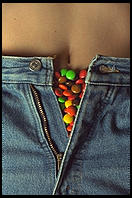
Whatever lighting system you get, make sure that it is reasonably popular. Otherwise, you won't be able to get any accessories to fit. You need to be able to control whether the light is hard or soft. Hard light is generated by a small and/or far-away light and results in strong shadows. Examples of hard lights are the sun (not small but quite far away) and bare bulbs. Soft light is generated by a large diffuse light and results in shadow-free images because there are many paths from the light source to the object. Examples of soft light are an overcast sky, a north-facing window close to the subject, a bulb reflected off an umbrella placed close to the subject.
Another dimension to control is diffuse/specular. A diffuse source contains light on many different angles whereas specular light is organized in parallel rays. Specular light doesn't bounce around the studio filling in shadows and lowering contrast, spilling onto the background, etc.
Old-time photographers relied on silver umbrellas to get a somewhat softer light source. With white translucent umbrellas, you can use them like a silver umbrella and bounce off them (losing about 1/2 the light, which will go through and away from your subject) or push the light through them, which results in slightly harder light with the same 1-stop loss. However you use an umbrella, you'll generally get a diffuse light source.
The modern religion is the softbox, a reflector-lined cavity covered with a white diffusion fabric. The best of these, e.g., the PhotoFlex MultiDome, allow you to remove the front fabric to get a "sort of hard" light, to place or remove an interior baffle to get a "slightly less soft" light, and to warm up the color of the light with a gold reflector. Because softboxes surround the light head, you lose much less light than you would using white umbrellas. Note: the M&M image at the upper right was done with a softbox.
Some photographers put a big grid over the softbox to create a large specular source. Louvers create the same effect but only on one axis. An inexpensive honeycomb grid will turn a strobe head into a specular light source, albeit not a very large one. Photographers who use these tend to use many, "painting a scene" precisely with pools of light. Strobe head grids are $50-75 each or sold in sets with different light angles for about $200.
Snoots sit over a light head and turn it into a very small light source. These are usually used for hair lights. You can stick a small honeycomb grid over the snoot to tighten up the cone of light thrown by the snoot and also make the light more specular.
Barn Doors are black metal flaps that sit around a strobe head and keep the light from going where you don't want it to go. This is Hollywood technology from the 1920's. If you really want to control the angle of the light cone thrown by your head, you should probably get a zoom head or a bunch of grids.
Reflectors are really too general purpose to be called "studio equipment" but they are essential studio items and, if cleverly used, can eliminate the need for additional strobe heads. A favorite of mine is the PhotoFlex Litepanel, which is a huge sheet of gold/silver reflector, white diffusion fabric, or black light absorber in a plastic frame. You can light through this and turn it into a huge softbox, bounce off of it to bring the contrast ratio closer to that magic Kodak 3:1, or take it outside and have an assistant hold it to filter the sun. Another essential item is the disk reflector (e.g., Photoflex Lightdisc) which stores compactly but springs open to a large round reflector with a steel frame. I usually buy them white on one side, gold on the other.
The most important word in studio light control is "gobo". Hardly anyone knows what it means, but you can't beat the mysterious sound. It actually is short for "go between" and refers to anything that you stick in between the light and the subject to cast a shadow, diffuse the light, or whatever.
More: see the Photoflex Web site for a wide range of standard professional products. If you really want to understand the art of lighting, read books written for film makers and also look at old black & white movies (before they had color, they used lots of interesting gobos to add shadow patterns on white walls and other boring surfaces).
With hot lights, there is no need to worry about triggering the lights; they're on all the time. With strobes, the camera has to tell the strobes when to fire. This is traditionally done with a sync cord. Sync cords come in many lengths and are available coiled or uncoiled. The one thing in common that they all share is that someone will trip over one and probably pull something expensive down onto the floor. It is much better to use a wireless trigger of some kind. I have had good luck with the Wein infrared trigger system, which consists of a small on-camera hotshoe-connected flash with a filter over the front that only passes IR light. The other half of the kit plugs into your strobe powerpack and waits for the IR pulse from the on-camera unit, then triggers the flash. If you want to go fully wireless, you can get a mini Wein trigger that plugs into a flashmeter.
There are various radio slaves (e.g., Bowens, Morris, and Quantum) that also perform this function, possibly better in a large studio or outdoors.
Only a handful of cameras, e.g., certain Rolleis and Contaxes, have been manufactured with the capability of metering flash exposure with a through-the-lens in-camera meter. The standard practice of studio photographers is to use a handheld flash meter, a device that measures ambient light, light ratios, and calculates how many pops of a lower-powered studio strobe system you'll need to shoot at f/64 with your view camera. Even in the digital world where instant previews are available at no cost, a handheld meter is useful for determining whether or not the image is too contrasty to print easily.
Almost everyone uses a flash meter in incident mode. You start by connecting the meter to the strobes via a sync cord or a wireless trigger. You put a white diffusion dome over the meter and hold the meter in front of the subject's face, with the dome pointing back at the camera. You push a button on the meter, which triggers the flash. The meter then reports the appropriate f-stop to use. This gives you a reading that is independent of the subject's reflectance. In other words, if the subject is white the meter doesn't get fooled into thinking that it is a brighter light; if the subject is black, the meter doesn't recommend opening up two more f-stops until the subject is rendered as though it were 18% gray.
Though nobody was ever able to figure out how to use it, the standard professional meter for many years was the Minolta Flashmeter IV. Some of the truly technically adept were able to figure out what half of the buttons and switches do. Minolta rewrote the user's manual because nobody could understand the first one. Then they replaced it with the better/simpler Auto Meter VF and Flash Meter VI. Then they decided that they couldn't compete with Canon anymore and abandoned the photography business. Now we are back to Gossen and Sekonic, two companies that don't do too much besides make meters and therefore are able to concentrate on making good ones.
The Gossen Luna-Star F2 is a great example of the modern flash meter. It takes one standard 9V battery that you can buy anywhere. It only has six buttons and their functions are obvious. Without reading the manual, I was able to use all but one of the meter's modes within 60 seconds of putting in the battery. 99% of what you'd need to know from the manual is printed in four sections on the back of the meter. The meter is great for computing lighting ratios. You press the measurement button once to take a snapshot reading. You press and hold it while sweeping the meter around a scene and the Luna-Star F2 draws you a graph at the bottom of the display of the contrast range (e.g., f8-f16). Every time take a flash reading, the meter also shows you the ambient reading with an unobtrusive little bar on the same graph. Unlike the Minolta meters, you don't need a "reflected attachment" and an "incident attachment." The naked meter works to measure reflected light. Add a plastic incident piece and you can measure incident light. Add a little viewfinder and you've got a 5 degree spot meter. It is a great design and smaller than competing products. Nit: It only meters down to EV -2.5. That's a couple of stops less light than most pro SLRs but not as good as some other handheld meters.
Sekonic supposedly makes some great meters too, but I haven't tried them.
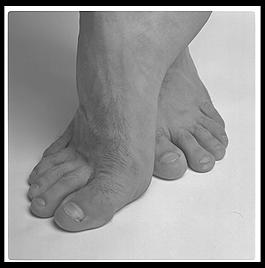
The basic professional background is seamless paper. This comes in rolls 53", 107", and 140" wide. The 53" size is too confining for photographing people, leading to stiff poses and nasty little slipups where a corner of the frame is not covered by the background. On the other hand, the 140" size is not necessary most of the time, which is why it is only available in a handful of colors. The 107" width is about 9 feet and that's a good size for most people. A roll costs about $30 and a good starter set would be white, "studio gray", and black. Colored seamless, or as we refer to it here in Cambridge, "seamless of color", tends to give pictures a Sears portrait studio look. Manfrotto makes a nice "Auto Pole" system that lets you mount several rolls of seamless conveniently (a few hundred dollars; can even be motorized).
For location work, Photek's Background-in-a-Bag system is kind of nice. These are big sheets of what looks like crushed velvet that you duct tape up against a wall. They fit into a included gym-bag.
Muslin is another standard studio background, available from amazon.com. If you want some color in a portrait background, muslin will look a lot better than colored seamless.
Obvious Answer #1 to the question of camera support is "Why do we need one? We're using a lightweight single-lens reflex camera and the strobes will freeze any camera shake?" Obvious Answer #2 is "Use a tripod."
Why use camera support? With hot lights, for maximum sharpness you need to ensure that the camera doesn't move during the exposure. With larger heavier cameras, a camera support will allow you to concentrate on composition rather than muscle fatigue. If you're attempting to be creative, a camera support enables discipline around camera position.
A tripod seems like the obvious way to support a camera, but there are much better options in the studio. A tripod is inconvenient. Since using the center column to adjust height reduces stability, you have to adjust all three legs to raise or lower the camera. You can't usually get really low or really high or really hanging out over your subject with a tripod because the legs get in the way.
Part of the reasons that tripods have so many shortcomings is that they are engineered to weigh less than 250 lbs. If you want the most stable support for a fixed weight, a tripod is the right design. Once you accept the idea that a camera support can weigh more than the photographer, there is more freedom of design and you'd probably come up with a Studio Stand. This is basically a heavy rigid single column off which you hang crossbar arms off of which you hang tripod heads off of which you hang cameras. There are wheels on the bottom that you can lock. The columns come between 6 and 12 feet in height and prices range from $350 to $3500 depending upon features and stability. Arkay, Davis and Sanford, Delta, Foba, and Manfrotto are the most common brands.
If you get bored with traditional studio work, try painting with light. If your studio can be completely darkened and your subject will hold still, the simplest way to do this is with a flashlight. Turn out the lights, open the camera shutter ("B" or "T" mode on a single-lens reflex), and walk around the subject and shine the flashlight on those parts of the subject that you wish to register on film. To make part of the subject brighter on film, hold the flashlight on that part for more time.
Light painting opens up a world of possibilities that are not available in the world of near-instant exposure. For example, for infinite depth of field, simply keep refocusing the camera as you light parts of the subject that are at different distances from the lens. To make just a portion of the subject diffuse, put a stocking over the lens while you're painting that part.
The Hosemaster was a $5000 fiber-optic light painting system that was all the rage when it came out in the early 1990s. Calumet took it over sometime in the late 1990s, but seems to have discontinued the core system.
Light painting was laborious in the film days. The photographer would
spend 15 minutes painting a scene on a Polaroid test exposure and then
do it all over again for the final slide. You would think that
digital cameras would be infinitely superior for this application.
Unfortunately, digital sensors introduce noise into the shadows during
very long exposures. Cameras and digital backs with large physical
sensors, e.g., at the bare minimum a
You went into the studio to have fun. Now it is time to stock up on mylar, strange oils, dead flowers, interesting vegetables, and play. If you want to spend more money, there are lots of interesting ways to do it. Rosco makes a huge range of colored filters to stick in front of lights plus fog machines ($350-700) to add mystery. A wind machine (around $500) will give human subjects that active look. Trengrove artificial ice cubes and related products will help you do that Chivas Regal ad.
Text and pictures copyright 1982-2007 Philip Greenspun